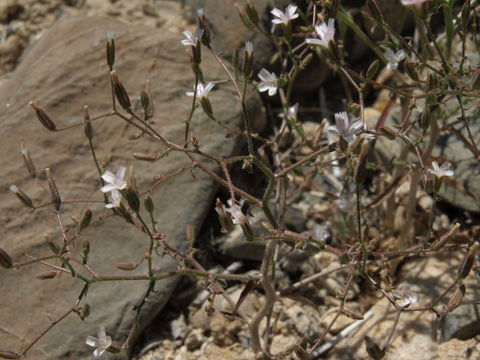
|
Family: Asteraceae |
Annuals, 5-30 cm; taprooted. Stems 1-5+, erect (leafy proximally, often flexuous distally), branched near base bases or distally, glandular-puberulent to glabrescent. Leaves basal or proximally cauline; sessile or petiolate; blades spatulate to oblanceolate, often runcinate, margins irregularly dentate to lobed, teeth often spinulose (faces glabrous). Heads (10-150+, on flexuous, bracteate, intricately-branched axes) in paniculiform arrays. Peduncles not inflated, minutely bracteate . Calyculi of 2-3, minute, deltate, unequal bractlets. Involucres ovoid, cylindric at flowering, 2-3 mm diam. Phyllaries 3. 5 in 1 series, linear-lanceolate, equal, herbaceous, margins hyaline, apices acute. Receptacles flat, smooth (with scars), glabrous, epaleate. Florets 3-4; corollas pink or white (slightly surpassing phyllaries at flowering). Cypselae pale brown, columnar, tapering slightly proximally, not beaked, 5-ribbed and grooved, minutely rugulose, glabrous; pappi tardily falling, of 80+, basally connate, white, unequal, stiff, smooth bristles. x = 7. The single species of Prenanthella was usually assigned to Lygodesmia in treatments prior to A. S. Tomb´s (1972b) reassessment. Its base chromosome number of x = 7 was taken as evidence of a possible relationship with Malacothrix, Calycoseris, and Anisocoma, also x = 7 (Tomb 1974). Recent molecular phylogenetic studies (J. Lee et al. 2003) place Prenanthella in a clade with Pleiacanthus, Stephanomeria, and Rafinesquia, all with x = 8. This group, together with Munzothamnus, constitutes the subtribe Stephanomeriinae of Lee and B. G. Baldwin (2004).
|
This project was made possible in part by the Institute of Museum and Library Services [MG-70-19-0057-19].
Powered by Symbiota



